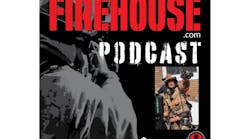In the past five years, 34 firefighters and EMS personnel have been killed and 80 injured in 95 "struck by" incidents recorded by the Emergency Responder Safety Institute. Four of these fatalities and 22 injuries occurred in the first five months of this year. The count may be even higher because of incidents that were not reported and it's known that the loss of life for police officers at accident scenes is much greater than for firefighters. (The Institute is sponsored by seven state fire associations in the Mid-Atlantic region and includes every branch of the fire-rescue service, both career and volunteer.)
The accident reports reveal that all of the standard procedures that are taken to protect an accident scene - flares, flashing lights and apparatus blocking traffic lanes - cannot guarantee the safety of emergency workers and may even contribute to a false sense of security. The list of dead and injured includes police officers and firefighters who were specifically assigned to control traffic, but became the victims of reckless, confused or impaired drivers.
"With the exception of fire-police units, most firefighters are not trained to direct traffic … It has become an incident command issue in determining where the apparatus should be positioned and who should be directing traffic," says Steve Austin, the Institute's project manager and a past president of the Cumberland Valley Volunteer Firemen's Association. In his view, everyone has to realize that they've entered an extremely dangerous environment when they arrive on the scene of an accident and step down from their engine, truck or ambulance.
Austin also believes that every fire company should carry reflective vests that can be pulled over their turnout coats when responding to accidents - the same as SCBA are donned while enroute to structure fires. "The reflective striping on our turnouts is not good enough for the highway," he points out.
One of the most vulnerable members is an engine company's pump operator, who has to be in the street next to the engine on every alarm, whether it's an accident or a fire. Several fatalities have occurred when pump operators were struck while standing near their engines; the Institute recommends that they should wear reflective vests on every run.
A top priority for the Institute is to push for mandatory driver education programs to warn the public on how to react when approaching an accident scene. "Every driver has to be taught what they should do when they see an emergency situation," Austin explains, "and it should start when they apply for their license and in high school driving classes." Motorists often become confused by the array of flashing lights on fire apparatus, ambulances, police cars and tow trucks that respond to an accident. In some situations, it may be better if some of the emergency lights are turned off when units reach the scene and only those that are needed to warn oncoming traffic should continue to operate.
One of the greatest threats comes from impaired drivers who are drunk, under the influence of drugs, or just plain tired and falling asleep at the wheel. Another menace is the reckless driver, who may be in a state of road rage and tries to make a high-speed swerve around an accident scene. For them, the only answer is strict laws that carry heavy fines and jail time. Twenty-three states have passed new laws calling for stiffer penalties for motorists who endanger emergency workers on the scene of an accident. It varies from state to state, with some that set a maximum speed and how many lanes of clearance must be given when driving around the scene.
The toughest may be an Illinois law that imposes a maximum $10,000 fine and loss of license for motorists who fail to proceed cautiously around parked emergency vehicles. It's known as "Scott's law" in memory of Scott Gillen, a Chicago Fire Department lieutenant who was killed when a driver ignored flares and warning lights, struck Gillen and pinned him against a ladder truck. It's not known how many arrests have been made or how many cases have been prosecuted since the law was passed two years ago.
While advocating new laws and driver education, Austin is convinced that the first step has to be improved training for firefighters on street and highway safety. "Many departments do not have standard operating procedures that cover accident scenes," he says. To help fill this void, the Institute has produced "Ten Cones of Highway Safety," a 20-minute training video that is available to fire departments at its website, www.respondersafety.com. There's no charge and it's another good starting point to help save firefighters' lives.
Hal Bruno, a Firehouse® contributing editor, retired as political director for ABC News in Washington and served almost 40 years as a volunteer firefighter. He is a director of the Chevy Chase, MD, Fire Department and chairman of the National Fallen Firefighters Foundation.




